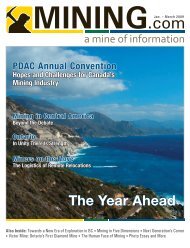Create successful ePaper yourself
Turn your PDF publications into a flip-book with our unique Google optimized e-Paper software.
Commodity<br />
Despite the Kimberley Process, blood diamonds still enter the legitimate trade.<br />
purchases and other illegal activities. Neighboring and other<br />
countries can be used as trading and transit grounds for illicit<br />
diamonds.<br />
Once diamonds are brought to market, their origin is difficult<br />
to trace and, once polished, they can no longer be identified.<br />
In order for a country to be a participant in the scheme, it must<br />
ensure that no diamonds finance a rebel group or other entity<br />
seeking to overthrow a UN-recognized government, that every<br />
diamond export be ac<strong>com</strong>panied by a Kimberley Process certificate<br />
and that no diamond is imported from, or exported to, a<br />
non-member of the scheme. After rough diamonds are mined,<br />
they are transported to Government Diamond Offices and the<br />
source of the diamonds is checked to ensure it is conflict free.<br />
The diamonds are then sealed and placed into tamper resistant<br />
containers and issued a government-validated Kimberley<br />
Process Certificate, each bearing a unique serial number. There<br />
are 74 countries that have implemented the principles of the<br />
Kimberley Process and have it enshrined in their national law.<br />
Only these countries may legitimately export rough diamonds.<br />
Diamonds can only be imported legally into one of the 74<br />
36 <strong>MINING</strong>.<strong>com</strong> September 2008<br />
Kimberley process countries. Once diamonds are imported,<br />
the government customs office, in conformance with its national<br />
procedures, checks the certificate and seals on the container.<br />
Any rough diamonds without a government-validated Kimberley<br />
Certificate or that are unsealed are turned back or impounded<br />
by Customs.<br />
Once a diamond has been legitimately imported, it is ready<br />
to be traded, cut and polished and set into jewelry. Several<br />
<strong>com</strong>panies may be involved in this process. Each time the diamond<br />
changes hands it must be ac<strong>com</strong>panied by a warranty<br />
on invoice stating that the diamond is not from a conflict source.<br />
This is called the System of Warranties. Manufacturers/traders<br />
are required to audit these System of Warranties statements on<br />
their invoices as part of their annual audit process and to keep<br />
records for 5 years.<br />
The KPCS imposes extensive requirements on its members<br />
to enable them to certify shipments of rough diamonds as<br />
‘”conflict-free.” Each shipment crossing an international border<br />
must be transported in a tamper-resistant container and be<br />
ac<strong>com</strong>panied by a government-validated Kimberley Process




